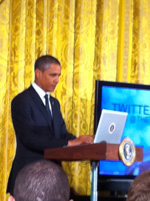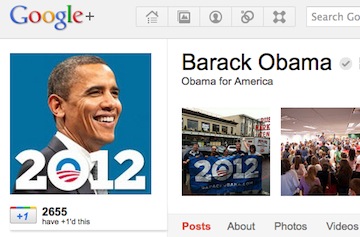Twitter Townhalls

{EAV:e47b9f8ac33e6b9b}Last summer I was invited to President Obama’s Twitter Townhall at the White House along with 139 other characters. Despite the grandiose setting and President Obama opening the event with a tweet (pictured here), I was thoroughly disappointed. Why? Because it wasn’t really a Twitter Townhall. Sure, the questions came in via tweets and where asked by Twitter board chairman Jack Dorsey, but all the answers were delivered via video. President Obama gave his answers to the camera in long-form.
Sure, there was a staffer in the room live-tweeting the president’s long answers (albeit abbreviated to 140 characters, minus the hashtag), but that isn’t the same thing as the president tweeting replies. As far as i am concerned, he might as well have taken the questions via email.
When I participate in a Twitter townhall, I expect it to take place on Twitter. The whole thing. Not just the questions.
After this event I made it my mission to hold a real Twitter townhall. My first outreach was to Senate Majority Leader Harry Reid. My colleagues at the Center for American Progress were hosting our annual National Clean Energy Summit with the Senator and I thought adding a Twitter townhall about clean energy jobs would be the perfect opportunity. And so did the Senator and his staff… until the news cycle overtook us. At the last minute, plans were changed and Reid hosted a Twitter townhall a la Obama style.
With short notice of the change, plans to host the entire townhall, along with real-time tweets translating the chat into Spanish, on Twitter were nixed. Instead, the Senator fielded general questions on creating jobs via Twitter and responded via video. The last minute change was understandable. The news cycle demanded the larger jobs context and a simpler format. And that is what it got.
But neither the Majority Leader’s office nor I were giving up on the pure Twitter play. A few weeks later, Reid’s social media director helped arrange a real twitter townhall addressing jobs and the Hispanic community with Senator Tom Udall (D-NM). In celebration of National Hispanic Heritage Month, we put together an amazing Twitter townhall that included the participation of the Center for American Progress (via @AmProg), Senator Tom Udall (himself), the #LATISM community (Latinos in Social Media) and Univision. And it was translated real-time into Spanish via @CAPespanol, American Progress’s Spanish language Twitter channel.
I developed a fairly straight forward format that took into consideration some of the quirks built into Twitter. Essentially, the 45 minute-long event went like this:
For a week prior to the event we promoted it via our various Twitter and Facebook channels. We also sent an email to our list inviting people to submit questions in advance using the #HHMchat hashtag (Hispanic Heritage Month chat). We made sure to include the already popular #HHM hashtag in our Twitter outreach to ensure that folks already tweeting about Hispanic Heritage Month would see our invites. On Facebook, we posted invitations to participate on several of American Progress’s pages, the Senator’s page, and other pages we found that were part of the national Hispanic community. Univision and #LATISM also promoted the event to its audiences.
During the townhall, we used the @AmProg screen name to host the chat, always including the #HHMchat, #HHM and #LATISM hashtags to ensure we reached the broadest interested audience.
At the outset, I welcomed everyone to the townhall, let people know they could follow in Spanish via @CAPespanol, and introduced the participants.
Then, for 20 minutes, the organizer of the #LATISM community, @ERGeekGoddess, asked questions about jobs and the Hispanic community of the #LATISM community. The answers flowed back from more than a hundred of them.
After this round of questions, I welcomed @SenatorTomUdall to the townhall. He made an opening statement via a few tweets and then we were off. For the next 10 minutes, @AmProg, @UnivisionNews and @ERGeekGoddess asked the Senator questions. Most of these questions were provided by my policy expert colleagues at American Progress.
Here is the tricky part… instead of @replying to the questions, Senator Udall retweeted the questions and then tweeted the answer via a few tweets without mentioning the questioner’s Twitter name.
Why?
Well, after Oprah did her big show on Twitter a couple years ago, traffic on the site exploded. In order to reduce the explosive demand for bandwidth, Twitter implemented an ingenious fix: If you reply to someone, the only people who see your reply in their homepage timeline are people who follow both you and the person your are replying to. That means most people who follow you won’t see your reply.
To break this constraint, you have to remove the “@” from the first space in your tweet. This is why you often see people tweet “.@reply” at the beginning of a tweet. It ensures your full audience will be delivered your tweet in their stream.
Unfortunately, adding the “.” before the “@” also breaks the conversation thread. That is why we retweet the question first and tweet the answer separately and without the @reply. It sounds a little complicated, but as long as you remember to
it will all work out just fine.
Getting back to the Udall townhall…
After 10 minutes of questions from the official participants, we opened the floor to audience questions. Senator Udall would choose a question from those tweeted at him (some in advance, some in real-time), retweet the question, then tweet his answer. If the answer needed a longer explanation, he used two or three tweets.
The senator had such a great time doing this that he stayed an extra 15 minutes, making the whole event an hour long.
Throughout the event, @CAPespanol retweeted everyone in Spanish and @AmProg retweeted everyone (as a central aggregator). And several of our policy experts who had provided the questions chimed in via their own Twitter accounts on the side.
In the end, we fielded a vibrant and informative discussion. The combined potential reach of the 200 participants was over 720,000 people and we generated over 7.9 million tweet impressions (as reported by TweetReach.com). That is a lot bigger reach than a typical congressional townhall.
Senator Udall had so much fun, he posted this video about the experience.
This Twitter townhall was a pretty big production, with a lot of moving parts. But they don’t have to be so complicated.
About a month later, we hosted a more casual Twitter chat with Senator Kirsten Gillibrand (D-NY). @SenGillibrand joined my colleague Heather Boushey (@HBoushey) for a 45-minute conversation about women and the economy. This time, the townhall was much simpler. Using our @CAPaction Twitter channel, I essentially moderated the conversation, welcoming everyone, introducing the senator, Heather and the topic (as well as the #OTSchat hashtag we used to aggregate the conversation).
For this event, Heather asked a few questions, the Senator replied, Heather added a couple more comments and then they moved on to the next topic. Meanwhile, @CAPaction retweeted the whole thing. Eventually, other people joined in the discussion… interested citizens, @MomsRising, and more.
Originally scheduled for 30 minutes, the senator had so much fun, she stayed an extra 15… only leaving because she had to vote on a bill.
We used the same process as before… retweet the question, then follow with the answer… but we didn’t translate it or have other panelists. This made the event much simpler and more casual.
So now, with two of these under our belt, we are looking to do more. Stay tuned.





